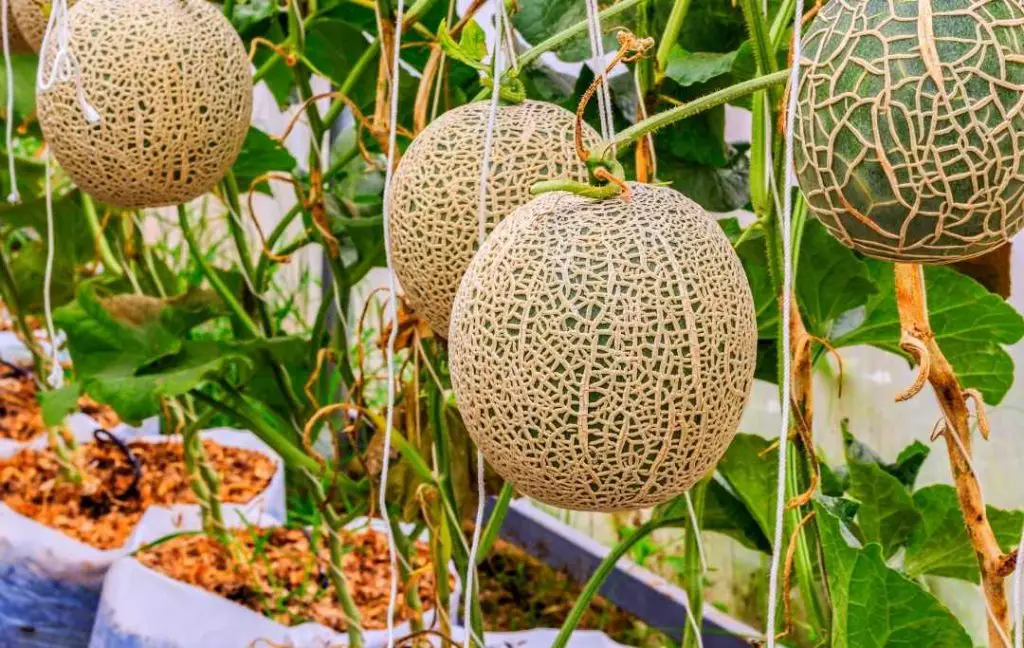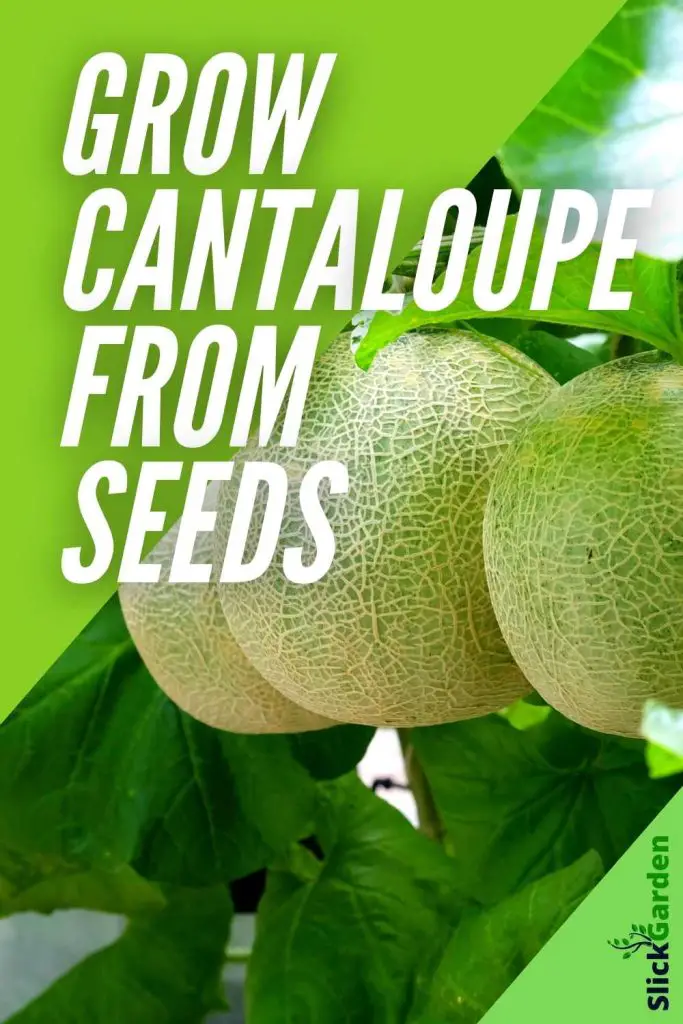Cantaloupe Gardening Tips Turning Ovwr
Some people are facing the problem of limited space but they can grow plants in containers easily. In this article, we are going to discuss how to grow cantaloupe in containers.

The sweet cantaloupe thrives in containers if you fulfill all the requirements. You will get all the information and tips about growing cantaloupe in containers.
It means whatever the size of your garden you can enjoy this sweet treat. Cantaloupe is a water-rich fruit and is a source of essential nutrients.
Why Grow Cantaloupe In Containers?
Cantaloupe belongs to the Cucurbitaceae family, watermelon pumpkins and cucumbers are its fellow members. Catalogues like to grow in a warm climate.
The best temperature for growing cantaloupe should be between 70 to 90 degrees Fahrenheit. It can tolerate the night temperature of 50 degrees Fahrenheit.
Container gardening is good for both hot and cold climates.
- COLD CLIMATE: If you are living in a cold climate then you should grow cantaloupe in containers. It is a good match for cold climate growers. It's up to you whether you grow cantaloupe indoors or in greenhouses.
- HOT CLIMATE: Container gardening is also a good option for hot locations as well. You know melons like to grow in warm areas but if the temperature rises above 100 degrees Fahrenheit then you should protect your catalogues from extremely hot weather. Containers are the perfect choice in this situation.
You will be successful if you choose to grow cantaloupe in containers due to the flexibility that offers container gardening. Containers make it possible for you to grow cantaloupe at any time of the year. It means containers make them an annual plant.
Right Type Of Cantaloupe For Containers
As you are a growing cantaloupe in the containers then it is better to choose dwarf varieties. As they have shorter vines and smaller melons.
These types of varieties are suitable for small spaces. Following are the recommended varieties which you can easily grow in containers.
1- SUGAR CUBE
This is a hybrid and disease-resistant variety which produces sweet and flavourful melons the weight of the metals can be two pounds.
2- MINNESOTA MIDGET
This vine can be reached at a height of 3 feet of this variety. It produces tiny and meaty melons.
3- TUSCANITO
This is an Italian variety that produces sweet melons. The weight of the melon can be two pounds. You can store it in the refrigerator for up to two weeks.
4- CHARENTIAS
Smooth, round and greyish melons produced by this French heirloom. The weight of the most flavorful melons can be up to 2 pounds.
5- TASTY BITES
Insan this variety produces rich and sweet flavor of round or oval melons. The weight of each melon can be two and a half pounds.
Choosing The Right Container
Vining plants need space for their roots, to fulfill this requirement you should use a large container. The size of the container must be 16 inches deep and 14 inches wide.
Barrel planters are also a good option for this purpose. You can use pots that are made from terracotta, sturdy plastic, or breathable fabric.
It doesn't matter what type or size of container or pot you are using, make sure it has drainage holes at the bottom. Without drainage holes, your plant may be affected by root rot.
You can also place pebbles at the bottom of the container for better drainage. But you should use pebbles, in that case, if you don't want to move the container. After adding the pebbles it will become heavier.
Preparing Potting Mix For Filling The Container
The best thing about container gardening is that you can maintain the fertility of the soil which is not possible when you grow plants in the ground. You should avoid using the garden soil. You can use high-quality potting soil that drains well. This type of soil is rich in organic matter.
You can also prepare your planting mix by combining topsoil, compost, and well-rotted manure. When you add perlite or vermiculite in your planting mix then it will help to retain the moisture in the soil.
It is suggested that you should use all-purpose or slow-release fertilizer at the time of the planting or transplanting. This will make your soil perfect and full of nutrients. You can also eat 5-5-5 liquid fertilizers when your seedling reaches the height of 6 inches.
Read More
- 15 Simple And Inexpensive Homemade Fertilizers
- How To Make A Diy Compost Bin
- 10 Vegetable Garden Trellis Ideas
How To Grow Cantaloupe From Seeds?
You should use seeds of high quality which are easily available from any local nursery or gardening store. If you use the right seeds then you will get a superior yield.
This will make your success chances very bright. Both ways are right for growing cantaloupe, sowing seeds directly in the containers or starting them in seed trays.
Prepare The Seedlings
If you are living in a cold climate it is better to sow the seeds indoors and transplant them after the last frost passes. You can show the seeds in winter or spring.
If you prepare seedlings indoors then you can extend your growing season. You can use seed trays or plastic cups for preparing your seedlings.
- Fill the plastic cup seedling tray with potting soil.
- If you are using a plastic cup then put two seeds per cup.
- When your seeds sprout, keep the stronger seedling and discard the thin one.
- If you want your seedlings to grow faster then sprinkle some fertilizer in each cup or seedling tray.
- After 14 days you will see the seeds will start growing. Tiny fairy texture heart-shaped leaves will start emerging from the seeds.
- When you see the seedlings have two sets of true leaves then this is the right time of transplanting them in their permanent location.
- Before transplanting the seeds outdoors in the container you should be hard and there first. Daily place them in the sunny light for a few hours.
- Gradually increase the time day by day for transplanting.
- Now dig holes in the soil of the container. The size of the hole must be according to the root ball of the seedling. Gently remove the seedling from the tray and set each seedling in the container.
- If you want to make this process easier you should water the seedlings about half an hour before transplanting.
- Now your seedlings need regular sunlight. You should place your container at that place where they get the appropriate amount of sunlight.
Directly Sow In The Container
For the growers who live in warm areas, they can sow seeds directly in the container any time after the last frost.
- When you sow the seeds in the container, dig half-inch dip holes.
- Now drop 2 seeds in each hole.
- Make sure the pointy side of the seeds should be down in the soil.
- Cover the seeds with a thin layer of soil and use a spray bottle to water your seeds.
- Now cover the container with plastic to encourage the germination process. This will help to trap humidity inside.
- You should maintain the frequency of watering because cantaloupe needs moist soil. Whenever you feel the soil is dry then it is time to water your plants. Water thoroughly until it starts to drain freely from the bottom. Avoid overwatering because it is not good for your plant.

Training The Vines On A Trellis
When you decide to grow cantaloupe then you should install a strong and sturdy trellis in the container. Before transplanting the seedlings the roots of the plants don't like to be disturbed so it is better to install support earlier. The trellis will stop the vines from spreading on the ground. Proper support will make it possible that your plants to get fresh air and harvesting becomes easier.
Four container-grown cantaloupes, you can use bamboo u hoops. This is very easy and simple support for your plants. You can also use tomato cages or trellis for training the vine of cantaloupe. For training the plant, you need garden tape and wrap it around the vine. As the vines grow longer you can add more tape to attach new growth. For extra support to your catalog vines, you can use netted produce bags to sling the fruit to the structure.
PESTS AND DISEASES
Aphids, cutworms, cucumber beetles, and squash bugs are big problems for your catalog vines. In container gardening, it is easy to protect your plants from invasion by these tiny monsters.
You can control the population of aphids by spraying a strong blast of water. You can also use neem oil or insecticidal soap for fighting against cucumber beetles and cutworms.
Harvest Time
When you see the rind turns yellow and netting creamy gold then you can harvest cantaloupe. You should gently separate the melon from the stem. Before harvesting, you can also check the smell, spot where the vine meets the fruit smell sweet and juicy.
For a longer shelf life of your melons, you can wait until you see a slight depression at the stem. The flavor of such melons will not be so sweet.
Read More
- 8 Tips On How To Grow A Ton Of Turmeric At Home
- How To Grow Strawberry From Seeds At Home
- 12 Best Trellis For Cucumber In Raised Beds
Cantaloupe Gardening Tips Turning Ovwr
Source: https://slickgarden.com/growing-cantaloupe-in-containers/
Posted by: worrellhavoing69.blogspot.com

0 Response to "Cantaloupe Gardening Tips Turning Ovwr"
Post a Comment